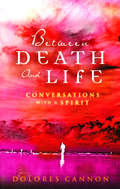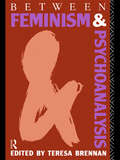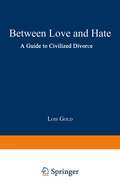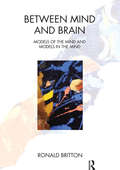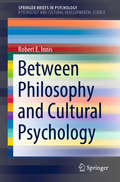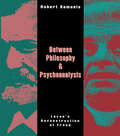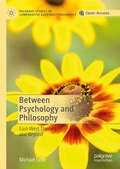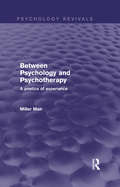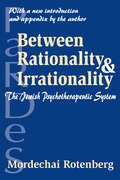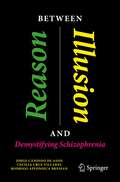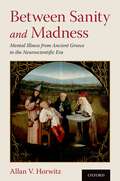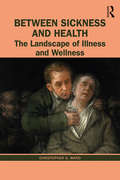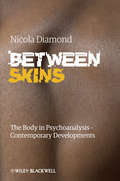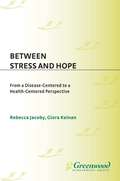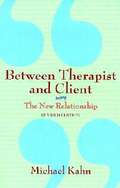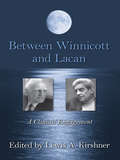- Table View
- List View
Between Death and Life – Conversations with a Spirit: An internationally acclaimed hypnotherapist’s guide to past lives, guardian angels and the death experience
by Dolores CannonOffering both comfort to the fearful and confirmation to the curious, Between Death and Life – Conversations with a Spirit examines different levels of existence in the spirit realms through hundreds of real people’s past life testimonies as revealed to widely published and internationally acclaimed past-life regressionist and hypnotherapist Dolores Cannon.What happens at the point of death?Where do we go afterwards?Does one’s personality survive after death?How are the good and the bad experiences of life accounted for?What is the purpose of life?These are questions everybody asks. And no one is better qualified to provide reasonable answers than Dolores Cannon. During forty years of detailed research, this widely experienced and well-respected American past-life regression therapist has accumulated a mass of credible information about the death experience and what lies beyond. While reliving their dying experiences, hundreds of subjects reported the same memories. The similarity and sincerity of their recollections are too convincing to be ignored.This eye-opening book explores the world beyond ours, giving us an insight into the death experience and reincarnation, guides and guardian angels, ghosts and walk-ins. It examines different levels of existence in the spirit realms; the ‘Healing Chambers’ for the damaged; the schools where you integrate lessons learned on Earth and where you discover the laws of the Universe; how you plan your next incarnation, the lessons to be learned and future karmic relationships before birth.Between Death and Life: Table of ContentsThe Death ExperienceThe GreetersA Near Death ExperienceThe Schools The Grand Tour The Different Levels or Planes of Existence So-Called ‘Bad’ LivesGuides God and Jesus Satan, Possession and DemonsGhosts and Poltergeists Planning and PreparationThe General Council Imprinting Walk-ins The Return Trip
Between Feminism and Psychoanalysis
by Teresa BrennanIn this landmark collection of original essays, outstanding feminist critics in Britain, France, and the United States present new perspectives on feminism and psychoanalysis, opening out deadlocked debates. The discussion ranges widely, with contributions from feminists identified with different, often opposed views on psychoanalytic criticism. The contributors reassess the history of Lacanian psychoanalysis and feminism, and explore the significance of its institutional context. They write against the received views on 'French feminism' and essentialism. A remarkable restatement of current positions within psychoanalysis and feminism, the volume as a whole will change the terms of existing debates, and make its arguments and concerns more generally accessible.
Between Feminism and Psychoanalysis
by Teresa BrennanIn this landmark collection of original essays, outstanding feminist critics in Britain, France, and the United States present new perspectives on feminism and psychoanalysis, opening out deadlocked debates. The discussion ranges widely, with contributions from feminists identified with different, often opposed views on psychoanalytic criticism. The contributors reassess the history of Lacanian psychoanalysis and feminism, and explore the significance of its institutional context. They write against the received views on 'French feminism' and essentialism. A remarkable restatement of current positions within psychoanalysis and feminism, the volume as a whole will change the terms of existing debates, and make its arguments and concerns more generally accessible.
Between Mind and Brain: Models of the Mind and Models in the Mind
by Ronald BrittonThis book begins with an exploration of the relationship between mind and brain. It then examines various psychoanalytic models of the mind and moves to the task of the analyst to discover the unconscious models that shape his or her patients' picture of him/herself and others. The familiar models are mainly drawn from psychoanalytic practice but are supplemented from myths, religion, and literature. Developments in adjacent scientific fields such as quantum biology and new ideas about evolution are discussed that suggest cellular genetic modification can take place as a consequence of interaction with the outside world. This gives hope perhaps to the idea that not only the mind can learn from experience but also the brain.
Between Mind and Brain: Models of the Mind and Models in the Mind
by Ronald BrittonThis book begins with an exploration of the relationship between mind and brain. It then examines various psychoanalytic models of the mind and moves to the task of the analyst to discover the unconscious models that shape his or her patients' picture of him/herself and others. The familiar models are mainly drawn from psychoanalytic practice but are supplemented from myths, religion, and literature. Developments in adjacent scientific fields such as quantum biology and new ideas about evolution are discussed that suggest cellular genetic modification can take place as a consequence of interaction with the outside world. This gives hope perhaps to the idea that not only the mind can learn from experience but also the brain.
Between Philosophy and Cultural Psychology (SpringerBriefs in Psychology)
by Robert E. InnisThis Brief provides an in-depth discussion of five major points of intersection between philosophy and cultural psychology. The first chapter frames central analytical and normative threads, foregrounding the focal notion of thresholds of sense. The second chapter explores the nature of contexts, situations, and backgrounds of meaning-making following the lead of John Dewey, Ben-Ami Scharfstein, and Gernot Böhme. Chapter three examines the complementary analytical power of the semiotic resources developed in the work of Peirce, Bühler, and Cassirer. Chapter four shows the heuristic fertility and psychological bearing of Susanne Langer's feeling-based aesthetic model of minding. The final chapter establishes affectivation as the inescapable consequence of human beings giving life to themselves by giving life to signs. The Brief concludes with three commentaries from leading researchers in the area. The chapters weave together interlocking themes: the nature of embodied perception, the variety of contexts and semiotic frameworks and their schematization of thresholds of meaning-making, the role of art and theories of imagination both in cultural psychology and in philosophy, and the centrality of feeling in all forms of meaning-making. Between Philosophy and Cultural Psychology will be of interest to cognitive and cultural psychologists as well as researchers and upper-graduate students in philosophy and related psychology fields.
Between Philosophy and Psychoanalysis: Lacan's Reconstruction of Freud
by Robert SamuelsFirst published in 1993. Routledge is an imprint of Taylor & Francis, an informa company.
Between Philosophy and Psychoanalysis: Lacan's Reconstruction of Freud
by Robert SamuelsFirst published in 1993. Routledge is an imprint of Taylor & Francis, an informa company.
Between Psychology and Philosophy: East-West Themes and Beyond (Palgrave Studies in Comparative East-West Philosophy)
by Michael SloteThis open access book discusses a variety of important but unprecedented ways in which psychology can be useful to philosophy. The early chapters illustrate this theme via comparisons between Chinese and Western philosophy. It is argued that the Chinese notion of a heart-mind is superior to the Western concept of mind, but then, more even-handedly, the relative strengths and weaknesses of Chinese and Western thought overall are critically examined. In later chapters, the philosophical uses of psychology are treated more specifically in relation to major issues in Western philosophy. Michael Slote shows that empathy and emotion play a role in speech acts (like assertion and thanking) that speech act theory has totally ignored. Similarly, he treats the age-old question of whether justice pays using psychological material that has not previously been recognized. Finally, the implications of psychological egoism are discussed in terms of some new psychological and, indeed, human distinctions. Human life is pervaded by instincts and aspirations that are neither egoistic nor altruistic, and recognizing that fact can help put egoism in its place. It is less of a challenge to morality than we have realized.
Between Psychology And Psychotherapy: A Poetics Of Experience (PDF)
by Miller MairIn this highly original and thought-provoking work the late Miller Mair puts forward his ideas for a new psychology. First published in 1989, he deals with issues of fundamental importance to the future of a psychology guided by genuine enquiry and concern rather than mere professional self-interest. Crossing and re-crossing boundaries between psychology, psychotherapy and philosophy, and between ‘science’ and ‘art’, he demonstrates the linkages between the personal and the impersonal, subject and object, inside and outside, with a daring not previously risked by anyone working in the area. Dr Mair stresses the importance of a poetic approach in psychology and psychotherapy, and the need to explore and understand the nature of psychology through an imaginative freedom of language. He emphasizes that a poetic awareness and attentiveness is fundamental to any pursuit of understanding of ourselves or others. This is a very personal book, concerned with personal knowledge, but it is meant for anyone who seeks to understand themselves and others, and what is involved in coming to such understanding. Focusing on ordinary human experience, and moving towards literary and artistic modes of expression, the author invites you to enter in, follow what you think and feel, as he proposes a radical revision of much that is accepted in psychology and in psychotherapy.
Between Psychology And Psychotherapy: A Poetics Of Experience
by Miller MairIn this highly original and thought-provoking work the late Miller Mair puts forward his ideas for a new psychology. First published in 1989, he deals with issues of fundamental importance to the future of a psychology guided by genuine enquiry and concern rather than mere professional self-interest. Crossing and re-crossing boundaries between psychology, psychotherapy and philosophy, and between ‘science’ and ‘art’, he demonstrates the linkages between the personal and the impersonal, subject and object, inside and outside, with a daring not previously risked by anyone working in the area. Dr Mair stresses the importance of a poetic approach in psychology and psychotherapy, and the need to explore and understand the nature of psychology through an imaginative freedom of language. He emphasizes that a poetic awareness and attentiveness is fundamental to any pursuit of understanding of ourselves or others. This is a very personal book, concerned with personal knowledge, but it is meant for anyone who seeks to understand themselves and others, and what is involved in coming to such understanding. Focusing on ordinary human experience, and moving towards literary and artistic modes of expression, the author invites you to enter in, follow what you think and feel, as he proposes a radical revision of much that is accepted in psychology and in psychotherapy.
Between Rationality and Irrationality: The Jewish Psychotherapeutic System
by Mordechai RotenbergJewish Scriptural interpretation entails a potential therapeutic bridge between the rational-material and the irrational-mystic in the world of psychotherapy. PaRDeS, as this system is known, is derived from the following concepts. "P" denotes peshat, the plain interpretation of the text, which translates into a rational interpretation of life. "R" symbolizes remez, hinting at a related religious concept, which becomes a symbolic view of life. "D" stands for derash, the homiletic way of interpreting a text, or a narrative reading of life. And "S" represents sod, or the mystery behind an idea, which in psychological terms becomes a mystic understanding of life. Mordechai Rotenberg believes that it is by engaging readings in a "dialogue" with each other, as in the Jewish hermeneutic tradition, the psychology underlying one's existence may be more readily understood. While Rotenberg acknowledges that it is legitimate to focus on one cognitive-rational or one narrative-storytelling therapeutic method in the course of therapy, he argues that a comprehensive theory of psychotherapy should include treatment possibilities for both rational and irrational manifestations of behavior, thereby engulfing all aspects of human behavior. For Rotenberg, a person's life becomes the "text," subject to being read and interpreted. If that person wishes to change his or her behavior via psychotherapy, then a hermeneutic system must be employed to understand that person's life. However, many systems interpret a person's life according to the particular theory espoused by the therapist. Rotenberg, in contrast, introduces a balanced theory bridging the rational and the irrational.Between Rationality and Irrationality emphasizes that it is more important for a therapist to learn his client's own "language" than to impose his own doctrinaire interpretation. This edition includes a new introduction by the author, as well as an appendix explicating an original psychological interpretation of PaRDeS
Between Rationality and Irrationality: The Jewish Psychotherapeutic System
by Mordechai RotenbergJewish Scriptural interpretation entails a potential therapeutic bridge between the rational-material and the irrational-mystic in the world of psychotherapy. PaRDeS, as this system is known, is derived from the following concepts. "P" denotes peshat, the plain interpretation of the text, which translates into a rational interpretation of life. "R" symbolizes remez, hinting at a related religious concept, which becomes a symbolic view of life. "D" stands for derash, the homiletic way of interpreting a text, or a narrative reading of life. And "S" represents sod, or the mystery behind an idea, which in psychological terms becomes a mystic understanding of life. Mordechai Rotenberg believes that it is by engaging readings in a "dialogue" with each other, as in the Jewish hermeneutic tradition, the psychology underlying one's existence may be more readily understood. While Rotenberg acknowledges that it is legitimate to focus on one cognitive-rational or one narrative-storytelling therapeutic method in the course of therapy, he argues that a comprehensive theory of psychotherapy should include treatment possibilities for both rational and irrational manifestations of behavior, thereby engulfing all aspects of human behavior. For Rotenberg, a person's life becomes the "text," subject to being read and interpreted. If that person wishes to change his or her behavior via psychotherapy, then a hermeneutic system must be employed to understand that person's life. However, many systems interpret a person's life according to the particular theory espoused by the therapist. Rotenberg, in contrast, introduces a balanced theory bridging the rational and the irrational.Between Rationality and Irrationality emphasizes that it is more important for a therapist to learn his client's own "language" than to impose his own doctrinaire interpretation. This edition includes a new introduction by the author, as well as an appendix explicating an original psychological interpretation of PaRDeS
Between Reason and Illusion: Demystifying Schizophrenia (Copernicus Books)
by Jorge Cândido Assis Cecília Cruz Villares Rodrigo Affonseca BressanThis book realistically describes the experiences of people living with schizophrenia and their families, from the detection of the first symptoms until the development of treatments and strategies to cope with this unique human condition. Schizophrenia is a form of psychosis in which subjective aspects, such as hallucinatory and delusional phenomena, tend to distort the understanding of reality. Because psychotic states fluctuate in intensity over time, those affected literally live between reason and illusion. Between Reason and Illusion: Demystifying Schizophrenia is an invitation to understand what it means to develop schizophrenia and to live with it throughout one's life. And this is an invitation to all those who are in some way affected by this condition: those who live with it, family members, friends, health professionals, and everyone who want to have a non-stigmatized view of mental disorders and people who live with them. “Faced with psychosis, the person affected by the disease and the family are lost and go looking for alternative or spiritual help, which usually delays the beginning of treatment. Jorge, Cecília and Rodrigo had the courage to face a difficult theme and the happy idea of writing a book of an educational nature about schizophrenia. The book's originality lies in the fact that it was written taking into account the experience of the person with the disease and his or her family members in the face of this something new that has occurred in their lives”. - Dr. Itiro Shirakawa, Professor Emeritus of the Paulista Medical School of the Federal University of São Paulo (UNIFESP/EPM), Brazil.
Between Sanity and Madness: Mental Illness from Ancient Greece to the Neuroscientific Era
by Allan V. HorwitzBetween Sanity and Madness: Mental Illness from Ancient Greece to the Neuroscientific Era examines several perennial issues about mental illness: how different societies have distinguished mental disorders from normality; whether mental illnesses are similar to or different from organic conditions; and the ways in which different eras conceive of the causes of mental disorder. It begins with the earliest depictions of mental illness in Ancient Greek literature, philosophy, and medicine and concludes with the portrayals found in modern neuroscience. In contrast to the tremendous advances other branches of medicine display in answering questions about the nature, causes, and treatments of physical diseases, current psychiatric knowledge about what qualities of madness distinguish it from sanity, the resemblance of mental and physical pathologies, and the kinds of factors that lead people to become mentally ill does not show any steady growth or, arguably, much progress. The immense recent technological advances in brain science have not yet led to corresponding improvements in understandings of and explanations for mental illnesses. These perplexing phenomena remain almost as mysterious now as they were millennia ago.
Between Sanity and Madness: Mental Illness from Ancient Greece to the Neuroscientific Era
by Allan V. HorwitzBetween Sanity and Madness: Mental Illness from Ancient Greece to the Neuroscientific Era examines several perennial issues about mental illness: how different societies have distinguished mental disorders from normality; whether mental illnesses are similar to or different from organic conditions; and the ways in which different eras conceive of the causes of mental disorder. It begins with the earliest depictions of mental illness in Ancient Greek literature, philosophy, and medicine and concludes with the portrayals found in modern neuroscience. In contrast to the tremendous advances other branches of medicine display in answering questions about the nature, causes, and treatments of physical diseases, current psychiatric knowledge about what qualities of madness distinguish it from sanity, the resemblance of mental and physical pathologies, and the kinds of factors that lead people to become mentally ill does not show any steady growth or, arguably, much progress. The immense recent technological advances in brain science have not yet led to corresponding improvements in understandings of and explanations for mental illnesses. These perplexing phenomena remain almost as mysterious now as they were millennia ago.
Between Sickness and Health: The Landscape of Illness and Wellness
by Christopher D. WardBetween Sickness and Health is about illness rather than disease, and recovery rather than cure. The book argues that illness is an experience, represented by the feeling that ‘I am not myself’. From the book’s phenomenological point of view, feelings of illness cannot be ‘unreal’ or ‘fake’, whatever their biological basis, nor need they be categorised as ‘physical’, ‘psychosomatic’ or ‘psychiatric’. The book challenges the disease-centred ethos of medicine and medical education. It demonstrates that a clearer conception of illness, as distinct from disease, is therapeutic. The feeling that ‘I am once again myself’ can return, in some degree, whatever state the body is in. Resilience becomes more available when it is seen as a set of personal skills that can be developed, rather than as an inborn trait. Possibilities of wellness are enhanced by recognising that medical and other therapies can either support or impede recovery, as can human relationships and the socio-political environment. The book’s many clinical examples are drawn from the author’s broad experience as a neurologist, rehabilitation physician and systemic family therapist. Between Sickness and Health will be useful for students, practitioners and academics, and also for anyone who has been or might one day be ill.
Between Sickness and Health: The Landscape of Illness and Wellness
by Christopher D. WardBetween Sickness and Health is about illness rather than disease, and recovery rather than cure. The book argues that illness is an experience, represented by the feeling that ‘I am not myself’. From the book’s phenomenological point of view, feelings of illness cannot be ‘unreal’ or ‘fake’, whatever their biological basis, nor need they be categorised as ‘physical’, ‘psychosomatic’ or ‘psychiatric’. The book challenges the disease-centred ethos of medicine and medical education. It demonstrates that a clearer conception of illness, as distinct from disease, is therapeutic. The feeling that ‘I am once again myself’ can return, in some degree, whatever state the body is in. Resilience becomes more available when it is seen as a set of personal skills that can be developed, rather than as an inborn trait. Possibilities of wellness are enhanced by recognising that medical and other therapies can either support or impede recovery, as can human relationships and the socio-political environment. The book’s many clinical examples are drawn from the author’s broad experience as a neurologist, rehabilitation physician and systemic family therapist. Between Sickness and Health will be useful for students, practitioners and academics, and also for anyone who has been or might one day be ill.
Between Skins: The Body in Psychoanalysis - Contemporary Developments
by Nicola DiamondBetween Skins challenges individualistic accounts of the body in psychoanalysis. Drawing on philosophy, contemporary neurobiology and developmental research, Nicola Diamond explores the ways in which bodily processes and skin experience are inseparable from the field of language and environmental context. The first book to address epistemological implications for a new understanding of the body and embodiment - offers a new perspective on the division between mind, body and world Brings together a philosophical phenomenological account of body experience with key concepts from psychoanalysis, developmental research and neuroscience Responds to a growing interest in the body and psychoanalysis, and considers some limitations in neuro-biological accounts of brain-body processes for psychoanalytical understanding
Between Skins: The Body in Psychoanalysis - Contemporary Developments
by Nicola DiamondBetween Skins challenges individualistic accounts of the body in psychoanalysis. Drawing on philosophy, contemporary neurobiology and developmental research, Nicola Diamond explores the ways in which bodily processes and skin experience are inseparable from the field of language and environmental context. The first book to address epistemological implications for a new understanding of the body and embodiment - offers a new perspective on the division between mind, body and world Brings together a philosophical phenomenological account of body experience with key concepts from psychoanalysis, developmental research and neuroscience Responds to a growing interest in the body and psychoanalysis, and considers some limitations in neuro-biological accounts of brain-body processes for psychoanalytical understanding
Between Stress and Hope: From a Disease-Centered to a Health-Centered Perspective (Praeger Series in Health Psychology)
by Rebecca Jacoby Giora KeinanThis volume focuses on the concepts of stress and hope, their psychological and physical outcomes. Past research has focused primarily or exclusively on either stress or hope and its effect on health. This work discusses them side by side and highlights their interrelations. Various theoretical approaches dealing with stress and hope are discussed, and a review of the most recent empirical data is presented. Also included are reports on individuals and groups that have been exposed to various stressful situations, such as racial prejudice, life threatening illness, or imprisonment. The role of hope in coping with these sitatuions is emphasized.Contributors to this edited collection are at the cutting edge of theory and research in the fields of stress and hope. Students and scholars studying health psychology, stress management or stress and coping will appreciate the information presented, as will those involved with medical science, nursing, and sociology.
Between Therapist and Client: The New Relationship (PDF)
by Michael KahnIn "Between Therapist and Client, " Michael Kahn explores what is perhaps the most important aspect of therapy - the therapist-client relationship. As he traces the history of the clinical relationship from Freud to the present, Kahn shows how the enmity between the humanists and the psychoanalysts limited their therapeutic effectiveness - and how their recent reconciliation has opened up exciting new possibilities for the way therapists relate to clients, pointing to a promising new period in the history of psychotherapy.
Between Therapist And Client: The New Relationship
by Michael Kahn Michael K. KahnPerhaps the most important aspect of the therapeutic process is the relationship between therapist and client. For years, two major schools of thought have strongly disagreed about what the nature of that relationship should be. The humanists emphasized warmth and empathy. The psychoanalysts kept a neutral, cool distance. Recently, however, the beginnings of a reconciliation between these traditions have opened new possibilities for the way therapists relate to clients. InBetween Therapist and Client, Michael Kahn shows why this new consensus is promising. Beginning with Freud's discovery of transference, Kahn traces the history of the clinical relationship from Carl Rogers' introduction of humanistic concerns through Merton Gill's theory and technique of transference analysis, to the pioneering work of Heinz Kohut, who has most successfully brought together psychoanalytic and humanistic thought. Using vivid examples from his own practice, Kahn shows how a coherent synthesis of these various approaches leads to the most successful clinical relationships. Completely updated with greater discussion of ethics and countertransference, the new edition ofBetween Therapist and Client is essential reading for those in psychotherapy both therapist and client.
Between Winnicott and Lacan: A Clinical Engagement
by Lewis A. KirshnerD. W. Winnicott and Jacques Lacan, two of the most innovative and important psychoanalytic theorists since Freud, are also seemingly the most incompatible. And yet, in different ways, both men emphasized the psychic process of becoming a subject or of developing a separate self, and both believed in the possibility of a creative reworking or new beginning for the person seeking psychoanalytic help. The possibility of working between their contrasting perspectives on a central issue for psychoanalysis - the nature of the human subject and how it can be approached in analytic work - is explored in this book. Their differences are critically evaluated, with an eye toward constructing a more effective psychoanalytic practice that takes both relational and structural-linguistic aspects of subjectivity into account. The contributors address the Winnicott-Lacan relationship itself and the evolution of their ideas, and provide detailed examples of how they have been utilized in psychoanalytic work with patients. Contributors: Jeanne Wolff Bernstein, James Gorney, Andre Green, Mardi Ireland, Lewis Kirshner, Deborah Luepnitz, Mari Ruti, Alain Vanier, Francois Villa .
